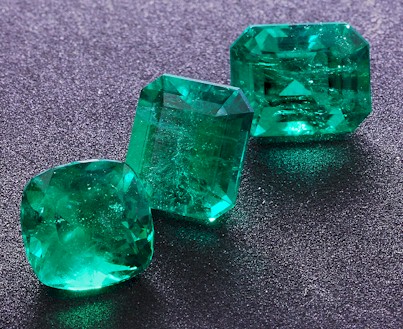The usual factors that determine the value of all colored gemstones are clarity, cut, color and carat weight. In the case of Emeralds, color and clarity dominate value determination.
 All Emeralds have inclusions. These inclusions are characteristics unique to the formation of Emeralds (and some other Beryl varieties) and actually aid in identification of natural Emeralds and separation from created (or synthetic) Emeralds.
All Emeralds have inclusions. These inclusions are characteristics unique to the formation of Emeralds (and some other Beryl varieties) and actually aid in identification of natural Emeralds and separation from created (or synthetic) Emeralds.
These include faceted pyrite crystals, calcite jardin (or garden), spindle shaped cavities, and three phase inclusions with gas bubbles contained in microscopic liquid-filled cavities within the crystal, indicative of hydrothermal formation associated with Colombian Emeralds.
Unlike other gemstones, these characteristic inclusions do not detract appreciably from the value of the Emeralds unless they are distracting or adversely impact the brilliance of the gemstone. Inclusions that are prevalent to the extent that they are distracting and diminish the brilliance of the Emerald will greatly reduce the value of the gemstone.
Which color is the optimum color for Emerald is widely debated, but it can be stated that the more intense the color, the greater the value. In Colombian Emeralds, "Muzo Green" is a term used to define leaf-green colors associated with Emeralds mined in the location of the Muzo mines. Emeralds mined in the Chivor region in Colombia tend to have bluish secondary undertones, similar to those of Zambian origin.
The color hue in Emeralds gives a clue as to origin, but cannot be the definitive test as far as origin, as Emerald hues from these three sources (as well as Brazil) can vary widely within each location. The key to the effect of color on Emerald valuations is color purity and intensity, regardless of source location.
Cut and carat weight have a decidedly secondary effect on Emerald values. Very large faceted Emeralds, in excess of ten carats, are quite readily available if one is willing to settle for lighter tones, less intense color or reduced brilliance. The same cannot be said for Diamonds, Rubies and Sapphires. However, very fine grades of Emerald over one carat are very rare and with respect to value may rival and sometimes exceed that of Diamonds of equal carat weight and grading.

Colombian emeralds will typically be the most expensive followed by Brazilian and Zambian stones. The reasoning is related to the color. Colombian emeralds get their color primarily from the trace amounts of the element chromium which is responsible for some of the purest greens in gemstones. Brazilian emeralds get their color primarily from trace amounts of the element vanadium and Zambian emeralds get their color from iron. Brazilian emeralds typically have a slight brown or gray cast and only sometimes match the pure green hue that many Colombian emeralds offer and Zambian emeralds often appear too blue due to their iron content. In reality though, emeralds from all three sources may be colored by more than one element.
All trademarks and logos shown herein are the property of their respective owners. © Copyright Multicolour Gems Ltd, 1998-2001. All rights reserved. Use of this site constitutes acceptance of Multicolour Return Policy, Privacy Policy and Trading Guarantee. Multicolour.com headquarters at # 59 Soi Pradit, Silom Soi 20, Bangkok, 10500, Kingdom of Thailand, Tel: +66 2 233-2108, Fax: +66 2 236-5274, E-mail to info@multicolour.com. Lost? Check Site Map. Site design and maintenance by NetComposite ®.
|